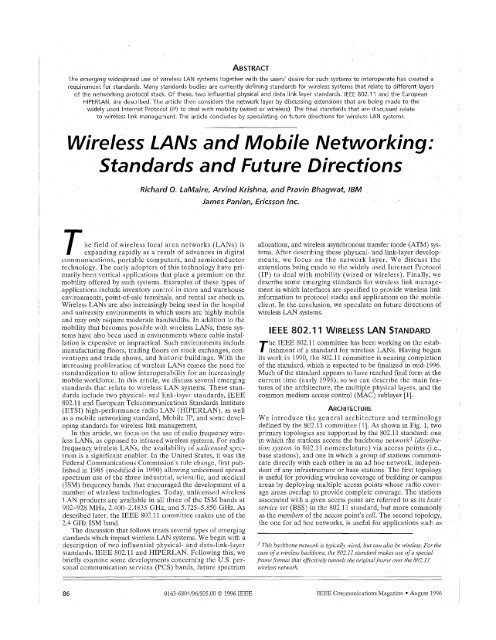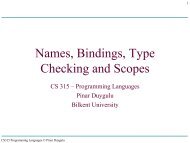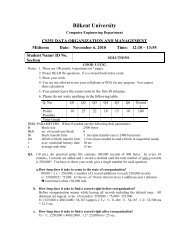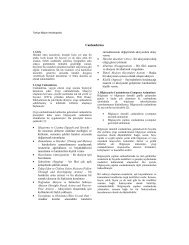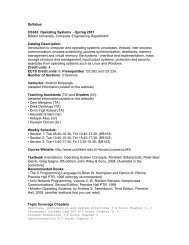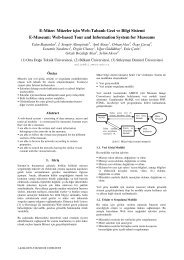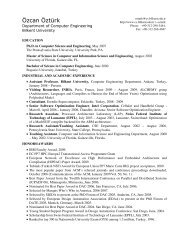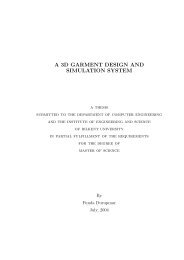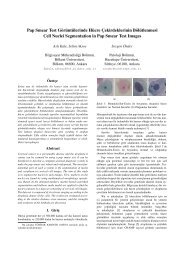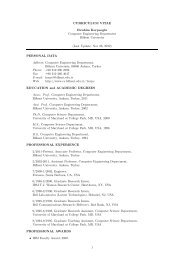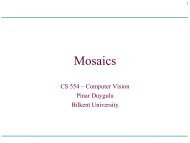Wireless LANs and Mobile Networking:
Wireless LANs and Mobile Networking:
Wireless LANs and Mobile Networking:
You also want an ePaper? Increase the reach of your titles
YUMPU automatically turns print PDFs into web optimized ePapers that Google loves.
ABSTRACT<br />
The emerging widespread use of wireless LAN systems together with the users' desire for such systems to interoperate has created a<br />
requirement for st<strong>and</strong>ards. Many st<strong>and</strong>ards bodies are currently defining st<strong>and</strong>ards for wireless systems that relate to different layers<br />
of the networklng protocol stack. Of these, two influential physical <strong>and</strong> data link layer st<strong>and</strong>ard3, IEEE 802.11 <strong>and</strong> the European<br />
HIPERLAN, are described. The article then considers the network layer by discussing extensions that are bcing made to the<br />
widely used Internet Protocol (IP) to deal with mobility (wired or wireless). The final st<strong>and</strong>ards that are discussed relate<br />
to wireless link management. The article concludes by speculating on future directions for wireless LAN systcms.<br />
<strong>Wireless</strong> <strong>LANs</strong> <strong>and</strong> <strong>Mobile</strong> <strong>Networking</strong>:<br />
St<strong>and</strong>ards <strong>and</strong> Future Directions<br />
Richard 0. LaMaire, Arvind Krishna, <strong>and</strong> Pravin Bhagwat, IBM<br />
James Panian, Ericsson Inc.<br />
T<br />
he field of wireless local arca networks (<strong>LANs</strong>) is<br />
exp<strong>and</strong>ing rapidly as a result of advances in digital<br />
comrrrrmications, portable computers, <strong>and</strong> semiconductor<br />
technology. The early adopters of this technology have primarily<br />
been vertical applications that place a premium on the<br />
mobility offcred by such systems. Examples of these types of<br />
applications include inventory control in store <strong>and</strong> warehouse<br />
environments, point-of-salc terminals, <strong>and</strong> rental car check-in.<br />
<strong>Wireless</strong> <strong>LANs</strong> are also increasingly being used in the hospii al<br />
<strong>and</strong> university environments in which users arc highly mobile<br />
<strong>and</strong> may only require moderate b<strong>and</strong>widths. In addition to the<br />
mobility that becomes possible with wileless <strong>LANs</strong>, these systems<br />
have also bccn used in environments where cable installation<br />
is expensive or impractical. Such environments include<br />
manufacturing floors, trading floors on stock exchanges, conventions<br />
<strong>and</strong> trade shows, <strong>and</strong> historic buildings. With the<br />
increasing prulireration of wireless <strong>LANs</strong> comes the need for<br />
st<strong>and</strong>ardization to allow interoperability for an increasingly<br />
mobile workforce. In lhis article, we discuss several emerging<br />
st<strong>and</strong>ards that relate to wireless LAN systems. These st<strong>and</strong>ards<br />
include two physical- <strong>and</strong> link-layer st<strong>and</strong>ards, IEEE<br />
802.11 <strong>and</strong> Europcan Telecommunications St<strong>and</strong>ards Institute<br />
(ETSI) high-performance radio LAN (HIPERLAN), as well<br />
as a mobile networking st<strong>and</strong>ard, <strong>Mobile</strong> IP, <strong>and</strong> somc developing<br />
st<strong>and</strong>ards for wireless link management.<br />
In this article, we focus on the use of radio frequency wire-<br />
Icss <strong>LANs</strong>, as opposed to infrared wireless systems. For radio<br />
frequency wireless <strong>LANs</strong>, rhe availability or unlicensed spectrum<br />
is a significant enabler. In the United States, it was the<br />
Federal Communications Commission's rule change, first published<br />
in 1985 jmodificd in 1390) allowing unlicensed spread<br />
spectrum use of the three industrial, scienrific, <strong>and</strong> medical<br />
(ISM) frequency b<strong>and</strong>s, that encouraged the development of a<br />
number of wireless technologies. Today, unlicensed wireless<br />
T,AN products are available in all three of the ISM b<strong>and</strong>s at<br />
902-928 MHz,' 2.400-2.4835 GHz, <strong>and</strong> 5.725-5.850 GHz. As<br />
described later, the IEEE 802.11 committee makes use of the<br />
2.4 GHz ISM b<strong>and</strong>.<br />
The discussion that follows treats several types or emerging<br />
st<strong>and</strong>ards which impact wireless LAN systems. We begin with a<br />
description of two influential physical- <strong>and</strong> data-link-layer<br />
st<strong>and</strong>ards, IEEE 802.11 <strong>and</strong> HIPERLAN. Following this, we<br />
briefly examine some developments concerning the U.S. personal<br />
communication services (PCS) b<strong>and</strong>s, future spectrum<br />
allocations, <strong>and</strong> wireless asynchronous transfer mode (ATM) systems.<br />
After describing these physical- <strong>and</strong> link-layer developments,<br />
we focus on the network layer. We discuss the<br />
extensions being made to the widely used Internet Protocol<br />
(IP) to deal with mobility (wired or wireless). Finally, we<br />
describe some emerging st<strong>and</strong>ards for wireless link management<br />
in which interfaccs are specified to provide wireless link<br />
information to protocol stacks <strong>and</strong> applications on the mobile<br />
client. In the conclusion, we speculate on futurc directions of<br />
wireless LAN systems.<br />
IEEE 802.11 WIRELESS LAN STANDARD<br />
he IEEE 802.11 committee has been working on the estab-<br />
T lishment of a st<strong>and</strong>ard for wireless <strong>LANs</strong>. Having begun<br />
its work in 1990, the 802.11 committee is nearing completion<br />
of the st<strong>and</strong>ard, which is expected to be finalized in mid-1996.<br />
Much of the st<strong>and</strong>ard appears to have reached final form at the<br />
current time (early 1996), so we can descrlbe the main features<br />
of the architecture, the multiple physical layers, arid the<br />
common medium access control (MAC) sublayer [l].<br />
ARCHITECTURE<br />
We introduce the general architecture <strong>and</strong> terminology<br />
deIined by the 802.11 cornmillee [l]. As shown in Fig. 1, two<br />
primary topologies are supported by the 802.11 st<strong>and</strong>ard: one<br />
in which the stations access the backbone network1 (distribution<br />
system in 802.11 nomenclaturc) via access points (Le.,<br />
base stations), <strong>and</strong> one in which a group of stations commnnicate<br />
directly with each other in an ad hoc network, independent<br />
of any infrastructure or base stations. The first topology<br />
is useful for providing wireless covcrage of building or campus<br />
areas by deploying multiple access points whose radio coverage<br />
areas overlap to provide complete coveragc. The stations<br />
associated with a given access point are referred to as its basic<br />
service set (BSS) in the 802.11 st<strong>and</strong>ard, but more commonly<br />
as the members of the acccss point's cell. The second topology,<br />
the one for ad hoc networks, is useful for applications such as<br />
I This backbone network id typicall+ wired, but can also be wireless. For the<br />
case of a wireless backbone, the 802.11 st<strong>and</strong>ard makes use of a special<br />
pame fomat that effecrively funnels he original finme over the 902.11<br />
wireless network<br />
86 0163-6804/96/$05.00 Q 1996 IEEE IEEE Communications Magazine August 1996
I<br />
Server<br />
.<br />
I<br />
file sharing in a conference room scenario.<br />
The MAC protocol of the 802.11 st<strong>and</strong>ard<br />
was developed to allow these two types of<br />
topologies to coexist, as illustrated by the<br />
overlap in thc coverage range of the ad hoc<br />
network <strong>and</strong> access point B in Fig. 1.<br />
As a prelude to the following discussion<br />
on the HIPERLAN st<strong>and</strong>ard, we mention<br />
that the IEEE 802.11 draft st<strong>and</strong>ard does<br />
not provide a mechanism for multihop<br />
routing, with the exception of the case discussed<br />
in the footnote above. That is, in an<br />
ad hoc network a station can only communicate<br />
directly with another station, <strong>and</strong> in<br />
the access point topology a station can only<br />
send packets (i.e.. frames) through the<br />
access point or directly to another station.<br />
No station can be used as a relay to the<br />
access point without the use of mechanisms<br />
that go-beyond those currently defined in the st<strong>and</strong>ard.<br />
PHYSICAL LAYERS<br />
The 802.11 draft st<strong>and</strong>ard providcs for thrce different types of<br />
physical layers to be used:<br />
2.4 GHz ISM b<strong>and</strong> frequency hopping (FH) spread-spectrum<br />
radio<br />
2.4 GHz ISM b<strong>and</strong> direct sequence (DS) spread-spectrum<br />
radio<br />
Infrared (IR) light<br />
Note that in Europe, the same 2.4 GHz b<strong>and</strong> (as the U.S.<br />
ISM b<strong>and</strong>) has been allocated to allow wireless LAN operation,<br />
whereas in Japan only the frequencies from 2.471 to<br />
2.497 GHz have been allocated (requiring special provisions<br />
in the IEEE 802.11 draft st<strong>and</strong>ard). In addition to having<br />
three types of physical (PHY) layers, two different data rates<br />
(I Mb/s <strong>and</strong> 2 Mbis) have been specified for each of the<br />
above PHY layers.2 At this point in timc, most of the attention<br />
has been directed toward the radio physical layers, so we<br />
will only consider these here. Note that the lnfrared Data<br />
Association (IrDA), a consortiun~ of leading U.S. <strong>and</strong><br />
Japanese. manufacturers of computers, communications eyuipment,<br />
<strong>and</strong> semiconductors, has been developing st<strong>and</strong>ards lor<br />
infrared-based attachment. While current IrDA st<strong>and</strong>ards<br />
focus on the replacement of the point-to-point serial/parallel<br />
cables thal connect computers to peripherals [2], future activities<br />
of the IrDA will focus on multipoint protocols as are used<br />
in LAN systems.<br />
The IEEE 802.11 committee allowed the definition of multiple<br />
PHY layers, in part, because the members of the committee<br />
had some interest in each of the aforementioned PHY<br />
layers <strong>and</strong> hcnce thcy sought to accommodate all of them.<br />
The benefit of this approach is that thc various advantages of<br />
each of the PHY layers can be exploited by users who want an<br />
802.11 -compliant wireless LAN [3]. The disadvantage is that<br />
two users need to specify additionally the type <strong>and</strong> data rate<br />
of their wireless LAN system to permit interoperability (e.g.,<br />
an 802.11 FH 1 Mb/s systcm). Thus, thc advantages of interoperability<br />
we experience with, say, wireline modem tcchnology<br />
are lost, as is the cost advantage of large volumes that<br />
would accompany the choice of a single PHY layer.<br />
In FH systems, the frequency at which data is transmitted<br />
is varied among a set of frequmcirs (i.e., 79 frequencies in the<br />
2 The 802.11 PHYsrundards specify the 2 Mbls data rate as optional, but<br />
all PHys are required to suppon the lower I Mbls rate. Furthermore, provisions<br />
are made to allow both speeds to coexist in the same channel.<br />
I<br />
I<br />
.._ ......<br />
..........................<br />
_. -. . __ . . .J<br />
Figure 1. <strong>Wireless</strong> architecture.<br />
U.S./European version of the 802.11 st<strong>and</strong>ard, <strong>and</strong> 23 in the<br />
Japanese version). That is, the transmitter sends data on a<br />
given frequency for a fixed length of time (i.e., the dwell time<br />
in 802.11) <strong>and</strong> then switches to the next frequency for another<br />
fixed length of time. The FH pattcrn is known to thc recciver<br />
so that the receiver's frequency synthesizer can hop in synchronism<br />
<strong>and</strong> recover the original data signal. The FH systems<br />
defined in the 802.11 PHY are slow FH systems since they<br />
transmit multiple consecutive symbols at the same frequency.<br />
In FH systems, adjacent or overlapping cells (Le.. BSSs) use<br />
different hopping patterns. For hopping patterns with many<br />
frequencies (e.g., 79 in the U.S./European 802.11 st<strong>and</strong>ard), it<br />
is unlikely that the same frequency will be used at the same<br />
time by two adjacent cells. The January 1996 draft st<strong>and</strong>ard<br />
specifies three different sets of hopping patterns, each of<br />
which is composed of 26 patterns (Le., 26 logical channels).<br />
The patterns within a given set have been chosen to exhibit<br />
good properties; for example, the consecutive frequencies in a<br />
given pattern arc spcctrally scparatcd by at lcast 6 MHz to<br />
avoid a narrowb<strong>and</strong> interferer.<br />
In DS systems, the original data signal is modulated by a<br />
wideb<strong>and</strong> spreading signal. This spreading signal is known to<br />
the receiver, which can then recover the original data signal.<br />
Note that in the 802.11 DS PHY, unlike multicode code division<br />
multiple access (CDMA) systems, only one predefined<br />
spreading signal is used. The factor by which the b<strong>and</strong>width of<br />
the signal is exp<strong>and</strong>ed is known as theyrocvssirrg gain of the<br />
DS system; in 802.11, it is 11 (10.4 dB), which permits some<br />
resilience to narrowb<strong>and</strong> noise <strong>and</strong> permits the 83 MHz U.S.<br />
b<strong>and</strong> to be segmented into a few channels (i.e., 11 DS center<br />
frequencies are defined in 802.11 for the US., but only three<br />
of these channels can be used without overlap).<br />
In summary, we note that since an FH system can offer a<br />
larger number of channels (i.c., frequcncy-hopping patterns)<br />
than a DS system, an FH systcm may bc more useful for dense<br />
environments in which cclls haw overlap with many adjacent<br />
cells. Furthermore, FH <strong>and</strong> DS systems have somewhat different<br />
types of resilience to narrowb<strong>and</strong> interference. FH systems<br />
expericnce the interference only for a fraction of time,<br />
whereas US systcms cxpcriencc a fraction of the interference<br />
power all of the time. Thus, FH systems have the performance<br />
advantage if the interference is high, DS systems if the interference<br />
is low. Currently, hoth types of radio systems, FH <strong>and</strong><br />
DS, have some manufacturers backing them. It remains to be<br />
seen whether the market will be winnowed to a dominant<br />
PHY layer or both types of PHYs will maintain significant<br />
market shares. Both of these types of radio systems aim to<br />
transmit at power levels of 100 mW or less, which will enable<br />
IEEE Communications Magazine August 1996<br />
a7
4 ..<br />
( . . ) I r.i.51 v I:~:;I.<br />
W Figure 2. PFimar?, access mechanism.<br />
them to achieve ranges of up to 100 m indoors, depending on<br />
data rate <strong>and</strong> building geometry <strong>and</strong> composition.<br />
MEDIUM ACCESS CONTROL<br />
The IEEE 802.11 draft st<strong>and</strong>ard defines a single MAC proto.<br />
col for use with all of the aforementioned physical layers. The<br />
use of a single MAC protocol better enables chip vendors to<br />
achieve high-volume production, which will help kccp thc<br />
costs low for these systems. There was considerable debate<br />
<strong>and</strong> compromise preceding the adoption of the current 802.11<br />
MAC pmtocol. The MAC protocol defined in the 802.11 draft<br />
is sophisticated <strong>and</strong> entails considerable complexity The protocol<br />
has a few options, as well as several features that can be<br />
turned on <strong>and</strong> off, <strong>and</strong> combines most of the functionality that<br />
was contained in the dozen 01 so hWC proposals considered<br />
by the committee [4].<br />
The important characteristics of the 802.11 MAC protocol,<br />
which are likely to remain umhangccl in the final st<strong>and</strong>ard,<br />
are its ability to support:<br />
The access-point-oriented <strong>and</strong> ad hoc networking topologies<br />
Both asynchronous <strong>and</strong> time-critical traffic (called timebounded<br />
services in 802.11)<br />
Power management<br />
'l'hc primary acccss method, the distributed coordination<br />
function (DCF), uscd in thc protocol 1s drawn from the family<br />
of carrier-sense multiple access with collision avoidance<br />
(CSMNCA) protocols. Since the radio medium does not permit<br />
the use of a collision detection (CU) mechanism, as uscd<br />
in thc CSMA/CD protocol of Ethernct, thc CSMNCA protocol<br />
uses a r<strong>and</strong>om backoff to reduce the likelihood of two<br />
frames colliding. Collisions are most likely to occur during the<br />
time period immediately following the transmission 01 some<br />
frame, since two or more stations may be listening to a busy<br />
medium <strong>and</strong> hence transmit when it becomes free. In the<br />
CSMA/C-4 protocol of 802.11, the r<strong>and</strong>om backoff time is distributed<br />
according to a uniform distribution (in discrete slot<br />
times) where the maximum extent of the uniform range is<br />
called the contention window (CW-) in 802.11. The CW parameter,<br />
that is, the range of this uniform distribution, is doubled<br />
(up to a maximum limit) each time a frame transmission is<br />
unsuccessful, as determined by the absence of an acknowledgment<br />
(ACK) frame. This exuonential backoff mechanism<br />
helps reduce collisions in response to increasing numbers<br />
of contending stations. Furthermore, as shown in<br />
Fig. 2, there is an initial interframe space (IFS) that<br />
can take on three different values representing priorities<br />
for transmission. The highest-priority frames are<br />
transmitted using the short IFS (SIFS). For example.<br />
the immediate acknowledgment that a receiving station<br />
sends back to the transmitting station makes use of the<br />
SIFS to guarantee that no other station intervenes. The<br />
next longest IFS, the point coordination function IFS<br />
(PIFS), is used to provide a priority mechanism by<br />
which time-critical frames can be transmitted before ,<br />
.. rier signals of one another. In this type of<br />
topology, the transmitters send frames<br />
without performing a r<strong>and</strong>om backoff<br />
(because the carrier signal of the other<br />
transmitter is never heard). This results in a high likelihood of<br />
collision. The 802.11 MAC protocol includes, as an option, a<br />
well-known mechanism to solve this hidden node problem.<br />
The protocol makes use of two control frames:<br />
A request to send (RTS) frame that a potential transmitter<br />
issues to a receiver<br />
A clear to send (CTS) frame that a receiver issues in<br />
response to a transmitter's RTS frame<br />
The CTS frame grants the requesting station permission to<br />
transmit while at the same time notifying all stations within<br />
radio range not to initiate any transmissions lor a given time,<br />
which is called the net ullocation vector (NAV) in 802.11.<br />
Because of the signaling overhead involved, the RTSCTS feature<br />
is not used for short packets,,lor which the collision likelihood<br />
<strong>and</strong> cost (in terms ol retrar~smisrion time) are both<br />
small anyway.<br />
In order to support time-bounded services, the 802.11 st<strong>and</strong>ard<br />
specifies the optional use of the aforementioned point<br />
coordination function (PCF) in which a point coordinator (or<br />
PCF tati ion)^ has priority control of the medium. That is,<br />
when the PCF is active, the PCF station allows only a single<br />
station in each cell to have priority access to the medium at<br />
any one time. This is implemented through the use of the previously<br />
mcntioned PIFS <strong>and</strong> a beacon frame (Fig. 3) that notifies<br />
all4 of the other stations in the cell not to initiate<br />
transmissions for the length of the contention-free period<br />
(CFP). Having silenced all the stations, the PCF station can<br />
thcn allow a given station to have contention-free access<br />
through the usc of an (optional) polling frame that is sent by<br />
the PCF station. Note that the length of the CFP can vary<br />
within each CFP repetition interval according to the system<br />
load. A typical wireless LAN iustallatioll would use different<br />
channels Tor adjacent cells to prevent two PCF stations (Le,!<br />
access points) from using (<strong>and</strong> hence colliding on) the same<br />
channel during the CFP. This would allow coexistence, even<br />
The PCF station IS always an accesspomt, so the we sf the PCF <strong>and</strong><br />
hence support for tzme-Domded sewices 1s limited to network3 with infrastructure.<br />
4 if one of the stations does not hear the apected beucon, It sets zts AiAVto<br />
a known mmzmum value for the length ofthe CFP.<br />
I !<br />
88 lhEE Communications Magazine * August 1996
-... . . . .<br />
1<br />
Prioritization Elimination<br />
Yield<br />
phase phase phase<br />
I==) 1<br />
on the same channel, with an ad Has 1-5 slots Has n+ 1 slots, n42 Has m slots, rn< 15 c<br />
hoc network that is using DCF only I Slot is 256 bits long Slot is 256 bits long Slot is 64 bits long<br />
(Fig. 1).<br />
I For each contending Each contending user,<br />
Most of the devices in which the the probability of<br />
user<br />
802.11 st<strong>and</strong>ard will be used have ~~7$~~dsf transmitting a buM of<br />
transmission<br />
defers<br />
for<br />
-<br />
Transmission starts<br />
power limitations (c.g., small h<strong>and</strong>- 1 synchron,zation iSl0&ii12~ iS0.5'''<br />
j slots, j< 14,<br />
held personal digital assistants), so of 256 bits<br />
with a probability<br />
- of O.lxO9<br />
options . for power conservation<br />
~<br />
were included in the MAC proto- Figure - 4. Channel access for HIPERLAN when the medium is sensed bus);.<br />
col. When a station is in the powersaving<br />
mode (is.. the doze state) it<br />
cannot transmit or receive frames; however, it does keep some<br />
timers operating. The 802.11 st<strong>and</strong>ard defines power manage-<br />
Pan-European countries <strong>and</strong> the uppcr two available only in<br />
some countries. The channel center frequencies start at<br />
ment procedures for cases with <strong>and</strong> without infrastructure 5.176468 GHz <strong>and</strong> arc separated by 23.5294 MHz. Gaussian<br />
(is., access points). In the presence of infrastructure, a dozing<br />
station periodically wakes up <strong>and</strong> listens to selected beacons<br />
sent by the access point. If the station hears a control frame<br />
minimum shift keying [ll] is the chosen modulation method,<br />
mainly for rcducing the adjacent channel interference <strong>and</strong> for<br />
amplifier efficiency considerations. The goal is to reach packet<br />
indicating that the access point has queued data for that sta- crror rates below A (31,26) BCH code [12] is used on<br />
tion, the station sends a special poll frame that tells the access<br />
point to send the data. In the absence of infrastructure, the<br />
power-conserving stations in the ad hoc cell wake up for only<br />
short predefined periods of time to hear if they should remain<br />
on to receive a frame.<br />
A final issue to consider for a wireless LAN st<strong>and</strong>ard is<br />
that of security to guarantee both privacy of the wirelessly<br />
transmitted data <strong>and</strong> to verify the authenticity of the wireless<br />
station or uscr. The 802.11 draft st<strong>and</strong>ard specifies an (optional)<br />
data encryption algorithm called the Wired Equivalency<br />
Privacy (WEP) algorithm. The WEP algorithm is based on the<br />
the bulk of the data packet, interleaved across 16 codewords.<br />
This leads to a block of 416 user data bits encoded to 496 bits.<br />
The coding scheme offers protection, in the sense of errorcorrection<br />
per block, from at least two r<strong>and</strong>om errors <strong>and</strong><br />
burst errors less than 32 bils long. Data packets consist of<br />
multiple blocks of user data. Each block has 416 bits of user<br />
data, <strong>and</strong> there are at most 47 blocks/packet. The high bit rate<br />
<strong>and</strong> proposed indoor use of HIPERLAN will require equalization<br />
to mitigate the effects of intersymbol interference. The<br />
st<strong>and</strong>ards define the usc of a particular 450-bit training<br />
sequence in every data packet, but stop short of defining the<br />
RC4 PRNG algorithm developed by RSA Data Security, Inc. equalizer precisely, leaving that to each implementation.<br />
[6]. The 802.11 st<strong>and</strong>ard describes a couple of mechanisms for The MAC protocol is based on a carrier-sensing mechasupporting<br />
authentication; however, the shared key mechanism<br />
is the only one fully defined at this time. As its name suggests,<br />
in this mcchanism the authentication of stations/users is based<br />
on the communicating stations having knowledge of a shared<br />
secret key.<br />
nism, but is quite different in its details from that used in the<br />
IEEE 802.3 st<strong>and</strong>ard (Ethernet) or the IEEE 802.11 st<strong>and</strong>ard<br />
discussed earlier. In case the medium has been sensed free for<br />
a sufficient length of time, 1700 bit times in this case, immediate<br />
transmission is allowed. If not, the channel access, in the<br />
T<br />
HIPERLAN<br />
he European community decided to pursue the goal of a<br />
wireless LAN that would bc indistinguishable in performance<br />
from wired <strong>LANs</strong> such as Ethernet, <strong>and</strong> also have<br />
some support for isochronous services. A committee was set<br />
up in 1991 under the auspices of the European Telecommunications<br />
St<strong>and</strong>ards Institute (ETSI) to formulate a HIPER-<br />
LAN st<strong>and</strong>ard. Unlike for thc IEEE 802.11 st<strong>and</strong>ard, this<br />
committee was not driven by existing products or regulations.<br />
A set of functional requirements was defined, <strong>and</strong> the committee<br />
set out to satisfy the requirements. 'The st<strong>and</strong>ards work<br />
was confined to the lowest two open systems interconnect<br />
(OSI) layers [7]. A draft st<strong>and</strong>ard was released in July 1995<br />
for imminent ratification [8]. The high bit rate requirements,<br />
coupled with the low power requirements for safety <strong>and</strong> othcr<br />
reasons, imply that each radio will have a short range (10-100<br />
m). Scenarios for usage <strong>and</strong> the choices considered for diffcrent<br />
aspects of the st<strong>and</strong>ard are described in [9, 101. In brief,<br />
the st<strong>and</strong>ard allows for a radio LAN system operating at<br />
23.529 Mb/s with support for multihop routing, time-bounded<br />
scrvices, <strong>and</strong> power saving.<br />
The high data rate together with the need for a number of<br />
channels require a reasonably large amount of spectrum, on<br />
the order of 150 MHz or more. The cornmittce identified two<br />
b<strong>and</strong>s, 5.15-5.30 GHz <strong>and</strong> 17.1-17.2 GHz. Currently, the st<strong>and</strong>ard<br />
addresses mainly the 5 GHz b<strong>and</strong>, which has been ratified5<br />
for HIPERLAN use hy the Conference of European<br />
Posts <strong>and</strong> Telecommunications Administration (CEPT). The<br />
b<strong>and</strong> is divided into five channels, the lower three available in<br />
terminology used in the HIPERLAN st<strong>and</strong>ard, consists of<br />
three phases: prioritization, elimination, <strong>and</strong> yield. The<br />
actions of each node in these three phases are described<br />
below <strong>and</strong> in Fig. 4. The prioritization phase is aimed at<br />
allowing only nodes having packets of the highest available<br />
priority to contend further for channel acccss. This phase consists<br />
of a number of slots, with a node having a packet with<br />
priority p transmitting a burst6 in slot p + 1 if it has heard no<br />
higher-priority burst. At the end of the first burst on the channel,<br />
the prioritization phase ends <strong>and</strong> the elimination phase<br />
begins. During the elimination phase, nodes that transmitted a<br />
burst during the prioritization phase now contend for the<br />
channel. This is achieved by each node transmitting a burst<br />
for a geometrically distributed number of slots <strong>and</strong> then lis-<br />
tening to thc channel for one time slot. If another burst is<br />
heard while listening to the channel, the node stops contending<br />
for the channel. Thus, only the node(s) with the longest<br />
burst will, in the absence of the hidden node problem, be<br />
allowed to further contend for the channel. Immediately after<br />
the longest burst <strong>and</strong> listening period of the elimination phasc<br />
is the start of the yield phase. In this phase, each of the sur-<br />
IIIPERLAN does not have exclusive use of either the 5 GHz or 17 GHz<br />
b<strong>and</strong> <strong>and</strong> can use these b<strong>and</strong>s on a non-protected basis <strong>and</strong> without interfering<br />
with other users.<br />
Roughtv speaking, a burst consists of transmitting the camerfrequency.<br />
More precisely, there is a particular hit sequence that is repeated for the<br />
duration of a bursl, but all receivers onb mpond to the received signal<br />
strength <strong>and</strong> not the particular hit sequence.<br />
IEEE Communications<br />
August 1996 Magazine<br />
89
~<br />
viving nodes defers transmission for<br />
a geometrically distributed number<br />
of slots, while listening to the channel.<br />
However, if they hear any<br />
transmission, they defer transmission<br />
altogether. The purpose of the<br />
elimination phase is to bring the<br />
number of contenders down to a<br />
small number, <strong>and</strong> then the yield<br />
phase tries to ensure that only one<br />
.,:: .......... . .:d..-,.L.-z-., ....... ....... ..........I_<br />
node eventually transmits.-As a ....-, ........<br />
result, the chanccs of actual collisions<br />
for data are negligibly small (less than 3 percent).<br />
The HIPERLAN technical committee wanted to explicitly<br />
support a quality or ssrvice (QoS) Tor packet delivery. QoS<br />
support is provided via two mechanisms, the iniiial value in<br />
both cases being assigned by the application using the HIPER-<br />
LAN services: the priority of a packet (high or normal) <strong>and</strong><br />
the packet lifetime measured in integral milliseconds with a<br />
range of 0-32,767 ms (cletault valuc, 500 ms). The residual<br />
lifetime of a packet together with its priority are used to<br />
determine its channel access priority. As described earlier <strong>and</strong><br />
shown in Fig. 4, the channel access priority can fall into one<br />
of five categories, <strong>and</strong> this priority is used for lhe priorilization<br />
phase described above. No other explicit mechanism is<br />
used to support the desired QoS, unlike the time-bounded<br />
services of the IEEE 802.11 st<strong>and</strong>ard. Since multihop routing<br />
is supported within the st<strong>and</strong>ard, the lifetime of a packet <strong>and</strong><br />
the residual lifetime are transmitted along with the packet.<br />
Packets that cannot be delivered within the allocated lifetime<br />
are discarded. Even though the original aim of the committee<br />
was to support statistically independent rates for different<br />
traffic classes. the choice of the MAC protocol together with<br />
the support for ad hoc networks <strong>and</strong> multihop routing allow<br />
only a best-effort type of service.<br />
'Thc comrnittcc envisioned that a pure ccllular architecture<br />
will not be sufficient for the system, hence allowing HIPER-<br />
LAN nodes to forward packets destined for other nodes. This,<br />
of course, requires the maintenance of routing databases at<br />
nodes <strong>and</strong> dynamically updating these databases. Methods for<br />
this topology maintenance have also been addressed in the<br />
st<strong>and</strong>ard, for both the daiahases at each node <strong>and</strong> broadcasting<br />
the information to other nodes. However, it is optional for<br />
a node Lo forwurci packets; hence, a node can also choose Lo<br />
forego this lunctiun, becoming a non[orwuvder in the terminology.<br />
An interesting discussiun of some of the issues involved<br />
can be found in [13].<br />
Power saving through both hardware-specific features <strong>and</strong><br />
protocol design have been addressed in HIPERLAN. The first<br />
method of power saving is via thep-saver method. In essence,<br />
a node can announce that it only listens periodically, with a<br />
short duty cycle for remaining powered up; this allows the<br />
node to power down most of its circuits at all other times.<br />
Other nodes wishing to transmit to it, namelyp-supporters,<br />
only send packets to the p-saver when they expect it to be listening.<br />
Furthermore, since there are broadcasts <strong>and</strong> multicasts<br />
on the air, there is support for deferred multicasts. Nodes that<br />
relay multicasts announce their schedule for doing so, allowing<br />
other nodes to power down except when they expect to<br />
hear multicasts. The final step toward power saving is through<br />
an innovative two-speed transmission method. Packets have a<br />
short low bit rate (LBR) header, at 1.4706 Mb/s. which contains<br />
enough information to inform a node whether it needs<br />
While the Europeans have<br />
ratified the use of spectrum<br />
for high-b<strong>and</strong>width wireless<br />
applications, the regulatory<br />
situation in the U.S.<br />
is still evolving.<br />
, . - . . .<br />
to listen to the rest of the packet or not. Thus, even if the<br />
node is listening it can keep the error correction, equalization,<br />
<strong>and</strong> other circuits powered off unless the LBR header informs<br />
it otherwise.<br />
__<br />
....<br />
There is support for packet<br />
encryption in the HIPERLAN<br />
packet transmission mechanism.<br />
The st<strong>and</strong>ard stays away from defining<br />
the particular encryption<br />
method used, but defines methods<br />
to inform the recciver which of a<br />
particular set of encryption keys has<br />
been used to encrypt the packet.<br />
The st<strong>and</strong>ard defines a small set of<br />
.................. such keys <strong>and</strong> how they arc kcpt at<br />
nodes. It does not, however, define<br />
any key distribution strategy, which would be a management<br />
function on top of the basic services. Another ETSI committee<br />
is working on a security st<strong>and</strong>ard for HIPERLAN, which<br />
will be required for conformance.<br />
The st<strong>and</strong>ard clearly defines a common air interface <strong>and</strong><br />
packet exchange mechanisms. However, there are interesting<br />
questions which will be answered only through building prototype<br />
systems <strong>and</strong> trial deployments. The rirst issue is that of<br />
channel selection. How will all of the nodes belonging Lo a<br />
logical HIPERLAN decide on a common channel? The channel<br />
access method strongly depends on carrier sensing. What<br />
impact will this have on the hidden node situation 151, <strong>and</strong><br />
how will the throughput be affected in such situations? Also,<br />
since the st<strong>and</strong>ard assumes that all of the nodes belonging to<br />
a HIPERLAN use only one channel, what user <strong>and</strong> traffic<br />
density can be tolerated, especially €or sewices requiring guaranteed<br />
delays? A final issue that we raise concerns power consumption<br />
for doing all the functions. This has been considered<br />
by the committee <strong>and</strong> other authors [9]. <strong>and</strong> was a factor in<br />
not choosing other modulation schemes that might have different<br />
power consumption profiles than the current choices.<br />
Some efforts aimed at building HIPERLAN systems <strong>and</strong> the<br />
technological factors involved are described in [14].<br />
OTHER STANDARDS<br />
11 September 1993, the FCC allocated unlicensed b<strong>and</strong>s for<br />
I new personal communications service (PCS). Subsequently,<br />
in a June 1994 ruling, the FCC reduced the allocated b<strong>and</strong> [or<br />
unlicensed PCS to a 20 MHz b<strong>and</strong> from 1.910 to 1.930 GHz,<br />
segmented into a 1.910-1.920 GHz subb<strong>and</strong> for asynchronous<br />
applications such as wireless <strong>LANs</strong> <strong>and</strong> a 1.920-1.930 GHz<br />
subb<strong>and</strong> for isochronous applications such as cordless telephones.<br />
A device operating in the asynchronous subb<strong>and</strong> must<br />
follow a special Listen-Before-Talk (LBT) etiquette, which is<br />
designed to allow multiple systems to coexist in the same<br />
vicinity. It is important to note that these new PCS b<strong>and</strong>s are<br />
currently occupied by point-to-point microwave links, <strong>and</strong> it<br />
may take several years to fully clear these b<strong>and</strong>s for wireless<br />
LAN users. The reclamation of the unlicensed PCS b<strong>and</strong>s is<br />
being conducted by UTAM, Inc. (Unlicensed PCS Ad Hoc<br />
Committee for 2 GHz Microwave Transition <strong>and</strong> Management),<br />
a non-profit coalition of equipment manufacturers.<br />
UTAM intends to collect fees from the manufacturers of unlicensed<br />
PCS equipment in order to fund the relocation of the<br />
current microwave users. In addition, the FCC recently allocated<br />
(early 1995) an unlicensed data PCS b<strong>and</strong> from 2.390 to<br />
2.400 GHz in which the aforementioned LBT etiquette also<br />
must be used. The data PCS b<strong>and</strong> is currently clear, except for<br />
some government users authorized on a secondary, unprotected<br />
basis.<br />
While the Europeans (i.e., CEPT) have ratified the use of<br />
spectrum for high-b<strong>and</strong>width wireless applications (e.g.,<br />
5.150-5.300 GHz for HIPERLAN, as described in the previous<br />
section), the regulatory situation in the United States is<br />
90 IEEE Communications Magazine * August 1996
-~<br />
~<br />
I- ~<br />
I<br />
.~ ~~~<br />
MN -Care-of-address<br />
1<br />
1<br />
still evolving. In mid-1995, the FCC received two proposals<br />
for future allocations near 5 GHz. The <strong>Wireless</strong><br />
Information Networks Forum (WINForum) submitted I<br />
a proposal called the Shared Unlicensed Personal<br />
Radio Network (SUPERNET), which requested 250<br />
MHz of spectrum to support multimedia computer<br />
applications up to 20 Mbis. This proposal requested<br />
the b<strong>and</strong> from 5.100 to 5.350 GHz. A second proposal,<br />
submitted by Apple Computer Inc., with support from<br />
some othcr companies, rcquested a total of 300 MHz<br />
HA: Home agent<br />
of spcctrum, in two b<strong>and</strong>s, to support national infor- ~~~~$~a,g,e,n,’~~~ e<br />
mation infrastructure (NII) wideb<strong>and</strong> MN applications.<br />
The so-called N11 b<strong>and</strong> proposal requests the b<strong>and</strong>s I ..... ~. . . ...-...... . .<br />
from 5.150 to 5.300 GHz (i.c., the HIPERLAN b<strong>and</strong>) W Figure 5. <strong>Mobile</strong> IP architecture components.<br />
<strong>and</strong> from 5.725 to 5.875 GHz. Both of thcse proposals<br />
plan to adopt aspects of the HIPERLAN st<strong>and</strong>ard.<br />
In addition to these future directions, efforts are underway group to come up with a st<strong>and</strong>ard for near-term deployment<br />
to demonstrate wireless systems designed specifically for oper- within the Internet. The proposed modification to the IP 1201<br />
ation with ATM networks. One example of these efforts is the enables mobile nodes to change their network attachment<br />
recently initiated work of a European project called the Wire- points without disrupting any active network sessions. The key<br />
less ATM Network Demonstrator (WAND). The WAND pro- feature of the <strong>Mobile</strong> IP design is that all required functionalject<br />
was formed in answer to a call, from the European ities for processing <strong>and</strong> managing mobility information are<br />
Union, in the Advanced Communication Technologies <strong>and</strong> embedded in well-defined entities, the home agent (HA), for-<br />
Services (ACTS) program launched in 1995. The project is eign agent (FA), <strong>and</strong> mobile node (MN) (Fig. 5). The new<br />
run by a consortium of six European communications <strong>and</strong> functions defined by the st<strong>and</strong>ard allow an MN to roam on<br />
computer companies. The WAND project aims to research the Internet, without changing its IP address. Since <strong>Mobile</strong> IP<br />
<strong>and</strong> demonstrate the feasibility of using ATM over a high- exploits existing mechanisms available within IP, it is comspeed<br />
radio interface <strong>and</strong> seeks to achieve a data rate similar pletely transparent to the transport <strong>and</strong> higher layers <strong>and</strong> does<br />
to that of HIPERLAN (i.e., around 20 Mb/s). The HIPER- not require any changes to existing Internet hosts <strong>and</strong> routers.<br />
LAN effort has itself been extended into a family of stan- The Internet routing system routes a datagram to a host<br />
dards, with the one described in the last section being the first based on the network number contained in the nodc’s Intercompleted.<br />
A second HIPERLAN st<strong>and</strong>ard will be aimed at net address. If a node changes its point of attachment <strong>and</strong><br />
mobile wireless ATM (in the 5 GHz b<strong>and</strong>), <strong>and</strong> its st<strong>and</strong>ard- moves to a new network, IP datagrams destined for it can no<br />
ization efforts will be symbiotic with the WAND activities. longer be delivered correctly. The <strong>Mobile</strong> IP solution allows<br />
Other HIPERLAN st<strong>and</strong>ards will be aimed at higher speeds MNs to retain their addresses regardless of their point of<br />
<strong>and</strong> at the 17 GHz b<strong>and</strong>s.<br />
attachment to the network. When the MN visits a foreign net-<br />
MOBILE NETWORKING<br />
sing wireless network interfaces, mobile devices can be<br />
U connected to the Internet in the same way as desktop<br />
machines are connected, using Ethernet, token ring, or pointto-point<br />
links. The major difference, however, is that mobile<br />
devices can move while in operation, which means that their<br />
point of attachment to the network can change from time to time.<br />
From a network’s viewpoint, host movement constitutes a<br />
change in the network topology. It is natural that mobile users<br />
desire uninterrupted access to all networking services even<br />
while moving. Unfortunately, neither the Internet protocol<br />
suite nor the OS1 network architecture can provide this functionality.<br />
The assumption that end systems are stationary lies at<br />
the very foundation of the Internet <strong>and</strong> OS1 network architectures.<br />
This is a serious problem, since it is not possible to deploy<br />
a ncw mobility-aware protocol stack in the Internet, which<br />
already consists of tens of millions of hosts. The challenge lies<br />
in finding a solution that allows mobile nodes to function efficiently<br />
within the Internet architecture without requiring modifications<br />
to the existing infrastructure <strong>and</strong> host software.<br />
Over the past three years, many proposals have heen made<br />
for supportiug host mobility on datagram-based internetworks<br />
[15-191. The vast majority of these proposals have been<br />
designed to be compatible with today’s Transmission Control<br />
Protocol (TCP)/IP-based Internet. Except for the scheme proposed<br />
in 1191, which operates at the link layer, the rest of the<br />
proposals provide support for mobile networking at the network<br />
layer. To consolidate these efforts, the Internet Engiueering<br />
Task Force (IETF) has created a <strong>Mobile</strong> IP working<br />
work, it is associated with a care-of-address, which is an Internet<br />
address associated with the MN’s current point of<br />
attachment. The care-of-address identifies either the mobile<br />
host directly (if the address is acquired through Dynamic Host<br />
Configuration Protocol, DHCP) [21] or an FA responsible for<br />
providing access to visiting mobile nodes. The HA, which is<br />
located at the mobile node’s home network, maintains the<br />
binding between the MN <strong>and</strong> its care-of-address. When away<br />
from home, the mobile node registers its care-of-address with<br />
the HA; the HA is responsible for intercepting datagrams<br />
addressed to the MN’s home address <strong>and</strong> tunneling (encapsulating)<br />
them to the associated care-of-address. The FA decapsnlates<br />
the incoming packets <strong>and</strong> relays them to the MN.<br />
In this scheme, all datagrams addressed to an MN are<br />
always routed via the HA. However, the packets in the reverse<br />
direction (Le., originating from the mobile node <strong>and</strong> addressed<br />
to a stationary host) are relayed along the shortest path by the<br />
Intcrnet routing systcm. This gives rise to what is known as<br />
the triangle routingproblem. Routc optimization is possible if<br />
the location information (the association between the MN <strong>and</strong><br />
its care-of-address) is allowed to be cached at the stationary<br />
host 1221. The stationaly host can use it to directly tunnel traffic<br />
to the care-of-address. Unless the location information is<br />
properly authenticated. there is a potential security risk<br />
involved in performing route optimization. Currently, therc is<br />
disagrecmcnt within thc <strong>Mobile</strong> IP working group on whether<br />
it is possible to support such an authentication mechanism<br />
within thc cxisting Intcrnet. Thcrefore, the current <strong>Mobile</strong> IP<br />
proposal does not permit route optimization.<br />
The <strong>Mobile</strong> IP working group of TETF, which was formed<br />
in the summer of 1992, is now in the final stages of releasing a<br />
IEEE Communications<br />
* August 1996 Magazinc<br />
91
1 Winrock?DLLljd NetDev DLL 7 ,<br />
.-<br />
-.-.- ...-<br />
\/ilinsock 2 service provider<br />
i\letDev service providpr<br />
inte!-face (SPI) interface (SPI)<br />
I<br />
-1<br />
I<br />
service<br />
proviy<br />
L-..<br />
I L . I<br />
Figure 6. Structure for application <strong>and</strong>protocol stack awareness of<br />
wireless links.<br />
st<strong>and</strong>ard request for comments (RFC). The working group is<br />
now focusing on defining an architecture for supporting<br />
mobility within Internet Protocnl version 6 (IPv6). Since the<br />
st<strong>and</strong>ards <strong>and</strong> 131-otocols for IPvh are still evolving, <strong>and</strong> there<br />
is no existing installed base of TPv6 hosts or routers with<br />
which the proposed solution must be compatible, IPv6 provides<br />
a unique opportunity <strong>and</strong> an unconstrained platform Tor<br />
developing the next generation of mobile internetworking protocols<br />
<strong>and</strong> applications. The first working group draft [23],<br />
therefore, improves on <strong>Mobile</strong> IP design in several ways. For<br />
example, the new design does not require FAs; MNs dynamically<br />
acquire a care-of-address using the IPV6 neighbor discovcry<br />
protocol. Sccond, by making all 1Pv6 nodes mobile-aware,<br />
the new protocol provides for direct tunneling of traffic to an<br />
MN’s care-of-address. The advantage of this design is that the<br />
load on HAS is significantly reduced, <strong>and</strong> the triangle routing<br />
problem is resolved.<br />
WIRELESS LINK MANAGEMENT<br />
here is a need for applications to he made aware of the<br />
characteristics of the wireless link. For example, wireless<br />
devices experience intermittent connectivity as a normal part<br />
of operating in a wireless network. A wireless user may experience<br />
a fade where the network connection is momentarily<br />
lost during a long Pile transfer. A mobile-aware application<br />
need not react by aborting the file transfer, but can instead<br />
suspend its application-layer time-outs <strong>and</strong> notify the user of<br />
the fade condition. When the mobile link is re-established, the<br />
application can resume the file transfer [X].<br />
Applications need to have access to slatus information to<br />
decide on the optimum wireless network to use. Information<br />
such as radio link speed, battery level, network Type (CDPD,<br />
Mobitex, etc.), network ID (the name of the service provider),<br />
<strong>and</strong> tariffing schedules can be used to algorithmically select<br />
the best network over which to run the application.<br />
WIRELESS LINK AWARENESS<br />
There are industry groups defining st<strong>and</strong>ards <strong>and</strong> specifications<br />
for providing wireless link information to protocol stacks<br />
<strong>and</strong> applications on the mobile client: the Personal Computer<br />
i<br />
Communications Association (PCCA) [Z], the Windows<br />
Sockets 2.0 <strong>Wireless</strong> Extensions Workgroup [26],<br />
<strong>and</strong> the group of companies defining the Windows<br />
Sockets (Winsock 2) specifications [24]. The st<strong>and</strong>ards<br />
<strong>and</strong> specifications are being created for the Windows<br />
95 <strong>and</strong> Windows IVT operating system environments.<br />
As shown in Fig. 6, the PCCA is defining enhancements<br />
to the Network Driver Interface Specification<br />
(NDIS 3.1) device driver model to provide wireless<br />
specific information to wireless <strong>and</strong> mobile-enabled<br />
protocol stacks. The Windows Sockets 2.0 <strong>Wireless</strong><br />
Extensions Group is delining the Network Device<br />
(NetDev) management interface to expose the wireless-specific<br />
information to wireless <strong>and</strong> mobileenabled<br />
applications. Winsock 2 is providing a<br />
common application programming interface (MI)<br />
where wireless protocol stacks (Mobitex, RD-LAP,<br />
etc.) can be selected by specific applications as well as<br />
traditional protocol stacks such as TCP/IP.<br />
The PCCA is defining wireless enhancements to<br />
the NDIS 3.1 device driver interface to make it possible<br />
for wireless-aware transports to get status informa-<br />
tion from the wireless network adapter so they can<br />
tune themselves <strong>and</strong> the wireless device for best performance.<br />
For example, the wireless-aware transport<br />
could be an existing User Datagram Protocol over IP<br />
(UDP/IP) stack modified to h<strong>and</strong>le the-special characteristics<br />
of a wireless network. The NDIS 3.1 enhancements are<br />
designed to also provide the functionality needed to support a<br />
wireless-awale APT such as NetDev. Receutly (March 1996),<br />
the PCCA issued the first version of their st<strong>and</strong>ard for wireless<br />
extensions to NDIS [E].<br />
An additional benefit ol providing a device driver interface<br />
to wireless devices is that multiple protocol stacks can bind to<br />
a single wireless device <strong>and</strong> simultaneously transmit <strong>and</strong><br />
receive data over the device. This enables the wireless user to<br />
run multiple applications over multiple protocol stacks with<br />
the wireless device just likc a LAN-based user does today,<br />
running over Ethcrnet or token ring.<br />
The Windows Sockcts 2.0 Wircless Extensions Workgroup<br />
is defining NctDev as a high-level API for applications to usc<br />
in managing wireless dcvices. NetDev allows the calling applications<br />
to enumerate installed devices, react to plug-<strong>and</strong>-play<br />
events, query <strong>and</strong> sct network parameters, <strong>and</strong> set network<br />
cvcnt triggcrs to enable asynchronous indications to the applications.<br />
A Winsock 2 application uses a QoS structure <strong>and</strong><br />
device status information from NetDev to select the optimum<br />
wireless transport. Winsock 2 provides a mechanism which<br />
enables the application to select the specific wireless device<br />
that the wireless transport uses by mapping socket h<strong>and</strong>les to<br />
NetDev device h<strong>and</strong>les. The Winsock 2 QoS structure also<br />
enables applications to be informed about a change in the<br />
network availability status when the mobile user experiences a<br />
fade or disconnection. The application is also informed when<br />
the connection is re-established. Additionally, Winsock 2 provides<br />
a mechanism that allows individual wireless transport<br />
providers to pass wireless link status information directly<br />
through Winsock 2 with transport-specific comm<strong>and</strong> codes.<br />
Table 1 shows some of the wide-area wireless status information<br />
that has been defined by the PCCA. This status information<br />
is common across a number of wide-area wireless<br />
network devices. Additional network-specfic status lnformation has<br />
also been defined for a number of networks such as DataTac,<br />
Ardis, Mobitex, <strong>and</strong> CDPD. Though the current definitions<br />
are for wide area networks. they can easily be extended for<br />
wireless LAN systems. In this case, it is likely that only a subset<br />
of the defined status information fields will be used.<br />
92 IEEE Communications August 1996 Magazine
~<br />
LOCAL AND REMOTE<br />
MANAGEMENT<br />
The <strong>Mobile</strong> Management Task<br />
Force (MMTF) has issued a draft<br />
mobile management information<br />
base (MIB) [27] for remotely managing<br />
many aspects of mobile communications<br />
using the Simple<br />
Network Management Protocol<br />
(SNMP). The MMTF is a coalition<br />
of companies that are working with<br />
existing st<strong>and</strong>ards organizations<br />
such as the IETF <strong>and</strong> the Desktop<br />
Management Task Force (DMTF)<br />
to propose extensions <strong>and</strong> modifications<br />
to existing st<strong>and</strong>ards <strong>and</strong> to<br />
encourage the development of new<br />
st<strong>and</strong>ards as needed. Thc MMW is<br />
currently examining an approach<br />
where DMTF management information<br />
formats (MIFs) are defined<br />
first, <strong>and</strong> then converted to Simple<br />
Network Management Protocol<br />
(SNMP) management information<br />
bases (MIRs) using an algorithm<br />
st<strong>and</strong>ardized within the DMTT:<br />
[28]. The MIFs <strong>and</strong> MTBs would<br />
include characteristics of both the<br />
mobile computing device <strong>and</strong> the<br />
mobile link lor both wired <strong>and</strong><br />
wireless mobile communications<br />
The use of the DMTF desktop<br />
management interface (DMI)<br />
offers similar functionality to Net-<br />
Dev <strong>and</strong> can also supply mobile<br />
link awareness to applications <strong>and</strong><br />
protocol stacks. Unlike NetDev,<br />
which is being specified for Windows<br />
95 <strong>and</strong> Windows NT, the<br />
DMTF DM1 is available on a variety<br />
of mobile operating systems<br />
(OS/2? DOS, Windows 3.1, AIX,<br />
Windows 95, Windows NT).<br />
i Network<br />
type [I<br />
Header format<br />
Indication request<br />
e current network being used by the wireless device. Examples are<br />
AMPS, DataTAC, Ardis.<br />
Specifies the frame format passed across NDIS. Examples are DIX Ethernet:<br />
frames, MPAK frames, RD-LAP frames, <strong>and</strong> MDC4800 frames.<br />
Allows protocol stacks to register to be notified of changes in other statusi<br />
information.<br />
1 Device information Supplies the manufacturer, model number, software version number <strong>and</strong> I<br />
'<br />
serial number wireless of the device. I<br />
! Operatlon mode The wireless device's power mode. Possible values are normal mode <strong>and</strong><br />
I power savings mode. I<br />
i Lock status \Indicates whether the wireless device is locked or unlocked.<br />
! Disable transmitter IUsed to enable or disable the wireless transmitter.<br />
j Network ID Returns the ID of the network with which the device is currently I<br />
communicating. An example is "XYZ Cellular Services".<br />
i<br />
1 Permanent address (Returns the device's permanent network address.<br />
i<br />
Suspend<br />
Thc use of SNMP over the wireless link has to be managed<br />
in an efficient manner. SNMP is very polling-intensive. Left<br />
unchecked, SNMP can introduce a large number of flows over<br />
the mrireless link. The wireless link is b<strong>and</strong>width- <strong>and</strong>, in many<br />
cases, tariff-constrained. Proxy agents can be used on the<br />
wired portion of the network to filter SNMP flows to the<br />
mobile. A proxy agent responds to SNMP requests for static<br />
information or information about the mobile link. A proxy<br />
agent passes SNMP requests that are related to dynamic system<br />
status infornlation directly through to the mobile.<br />
St<strong>and</strong>ards bodies <strong>and</strong> industry groups that are defining<br />
open wireless protocol st<strong>and</strong>ards are also delining MIBs lor<br />
managing the wireless communications layers. Two examples<br />
are the aforementioned IEEE 802.11 wireless LAN st<strong>and</strong>ard<br />
[1] <strong>and</strong> the CDPD specification [29].<br />
F.<br />
CONCLUSION<br />
ull'illing the promise of wireless <strong>LANs</strong> (i.e., the convenlence<br />
of tetherless access <strong>and</strong> the maintenance of ne~work<br />
sessions for mobile clients) affects all network protocol<br />
layers. We have described some of the activities that impact<br />
some of these layers in the previous sections. Of course, the<br />
impact is greatest in the lowest two layers, the physical <strong>and</strong><br />
Used to suspend or make operational the NDlS device driver. When suspended<br />
the device driver releases the serial port. This is useful if another<br />
application would like to access the device through the same serial port !<br />
the NDlS driver device was using.<br />
I<br />
the ID of the base station the device last contacted. Base station<br />
ID can also be monitored to determine when a h<strong>and</strong>off has occurred. 1<br />
the ID of the channel currently in use.<br />
i Channel quality Supplies the connection quality of the wireless link between the wireless<br />
device <strong>and</strong> the network. Also denotes whether the wireless device is in or 1<br />
1 out of range. I<br />
I Registration status Indicates whether the mobile has registration pending or registration<br />
I denied, or is registered.<br />
i<br />
I Radio link speed IReturns the radio link speed in bits per second for the current network. i<br />
1<br />
j Battery level Returns the current battery level <strong>and</strong> whether or not external power is<br />
connected to the wireless device.<br />
i<br />
L. ~. .. .~ - ~<br />
Table I. Wide-area wireless status information defined by the PCCA.<br />
data link layers, since the wireless medium is quite different<br />
from the traditional wired media. It is also in these two layers<br />
that the technical community has spent the greatest effort in<br />
the pursuit of wireless networking. Many advances have<br />
already been made, hut in conclusion we point out that the<br />
work in this area is far from done. Two techniques that have<br />
offered great benefits in the wide-area wireless networking<br />
arena are smart antennas <strong>and</strong> coded modulation schemes. An<br />
instance of smart antennas is the use of antenna diversity [30]<br />
to alleviate fading <strong>and</strong> other channel effects. Further use of<br />
smart antennas can be in both the lransnlission <strong>and</strong> reception<br />
of directional radio signals to improve the signal-to-interference<br />
ratio [31]. Recent advances in modulation (e.g., coded<br />
modulation, used in telephone modems) can also be used to<br />
advantage in local-area wireless systems. To date, the prohibitive<br />
signal processing requirements have not allowed<br />
sophisticated coded modulation schemes to be used at the<br />
high bit rates of indoor wireless systems, but these prohibitions<br />
are expected to lessen with technological advances. In<br />
this case, scherneb such as those described in [32] should be<br />
considered for use in wireless <strong>LANs</strong>.<br />
The next two layers of the networking stack, the network<br />
<strong>and</strong> transport layers, are also impacted by wirelessimobile networking.<br />
Note that the network layer, such as IP, is used to<br />
I<br />
!<br />
I<br />
I<br />
IEEE Communications<br />
August 1996 Magazine<br />
93
glue together disparate physical media <strong>and</strong> applications. As<br />
such, the desire to interoperate with existing hosts on the<br />
Internet is going to allow only incremental changes in this<br />
layer, as opposed to the development of a fresh new st<strong>and</strong>ard,<br />
which was possible in the lower two OS1 layers. There has<br />
also been much work done in underst<strong>and</strong>ing the impacts of<br />
both wireless <strong>and</strong> mobility on the transport layer <strong>and</strong> on flow<br />
control for data networks [33-361. However, this work is still<br />
ongoing <strong>and</strong> has yet to enter the st<strong>and</strong>ardization phase. Once<br />
we are past the network <strong>and</strong> transport layers <strong>and</strong> the incremental<br />
changcs thercin, intcroperability is more or lcss guaranteed.<br />
.4pplications <strong>and</strong> network management wili have to<br />
evolve in the future, as discussed in the last section, to take<br />
full advantage of the mobility offered <strong>and</strong> also to be aware of<br />
the wireless link.<br />
ACKNOWLEDGMENTS<br />
We thank the reviewers for their careful reading of the<br />
article. Their many useful suggestions have greatly improved<br />
the accul-acy <strong>and</strong> clarity of this article.<br />
REFERENCES<br />
[I 1 IEEE P802.11 D3, <strong>Wireless</strong> LAN Medium Access Control (MAC) <strong>and</strong> Physical<br />
Layer (PHY) Specifications, Piscataway. NJ, IEEE St<strong>and</strong>ards Dept.. Jan 1996.<br />
[2] "Infrared Data Assoclation Serlal Infrared Link Access Protocol (IrLAP),<br />
Verslon 1 .O," Infrared Datd Assoridtion; 5ee http //www.lrda.org/irda/<br />
content2.htmlj.<br />
[31 L. Goldberg, "<strong>Wireless</strong> <strong>LANs</strong>: <strong>Mobile</strong> Computing's Second Wave," Elect.<br />
Design. vol. 43, June 26, 1995, pp. 55-72.<br />
141 C. Linlts, W. Diepstraten, <strong>and</strong> V. Hayes, "Universal <strong>Wireless</strong> <strong>LANs</strong>," Byte,<br />
VO1. 19,MdY 1994, pp. 99-108.<br />
[5] H. Ahmadi, A. Krishna, <strong>and</strong> R. 0. LaMaire, "Design Issues in <strong>Wireless</strong><br />
<strong>LANs</strong>," I. High-speed Networks (JUSN), vol. 5, no. 1, 1996, pp. 87-1 04.<br />
161 B. Schneier, Applied Ciyptography, New York: Wiley, 1994.<br />
171 A. S. Tanenbaum, Computer Networks, 2nd ed., Englewood Cliffs, NJ:<br />
Prentice Hall, 1988.<br />
[81 ETSI TC-RES, "Radio Equipment <strong>and</strong> Systems (RES); Hlgh PErformance<br />
Radio Local Area Network (HIPERLANj; Functional Specification," ETSI,<br />
06921 Sophia Antipolis Cedex, France, July 1995, draft prETS 300 652.<br />
[9] T. Wilkinson, T. G. C Phipps, <strong>and</strong> S. K. Barton, "A Report on HIPERLAN Staw<br />
dardiration," lnt'l, J. <strong>Wireless</strong> info. Networks, vol. 2, Apr. 1995, pp. 9W20.<br />
[lo] G. Halls, "HIPERLAN -The 20 Mbit/s Radio LAN," /€E Elect. Div Colloqwm<br />
on Radio LAN8 <strong>and</strong> MANS (/E€ Colloqium Digest), no. 071, Stevenage,<br />
U.K., 1995, pp. 1/1-118.<br />
[Ill R. Steele, <strong>Mobile</strong> Radio Communications, London: Pentech Press, 1992.<br />
[12] F. I. MacWilliams <strong>and</strong> N. J. A. Sloane, The Theory of Error-Correcting<br />
Codes, North-Holl<strong>and</strong> Mathematicdl Llbrdry, Amsterdam. Elsevier Science<br />
Publishers B.V., 1986.<br />
[I31 C. E. Perkins <strong>and</strong> P. Bhagwat. "Highly Dynamic Destlnation-Sequenced<br />
Distance-Vector Kouting (USDV) for <strong>Mobile</strong> Computers," Proc. ACM SIG-<br />
COMM '94, London, U.K., Sept. 1994, pp. 234-44.<br />
[I41 P. Minnet, "Hiperlan: A European St<strong>and</strong>ard for 5 GHz <strong>and</strong> 17 GHz<br />
Wlreless LAN," Microwave Eng. Europe, Oct. 1995, pp. 61-66.<br />
[I 51 J. loannidis, D. Duchamp, <strong>and</strong> G 4. Maguire Jr., "IP-Based Protocols<br />
for <strong>Mobile</strong> Internetworkinq," Proc. ACM SIGCOMM '91, Zurich, Switzerl<strong>and</strong>,<br />
Sept. 1991, pp. 23525.<br />
[16] F. Teraoka et a/., "VIP: A Protocol Providing Host Mobility," Commun.<br />
ACM, VOI. 37, Aug. 1994, pp. 67-75.<br />
1171 H. Wada et a/.. "Moblle ComDutina Environment Based on Internet<br />
backet Forward/ng," Proc. Winter UZENIX, San Diego, CA, Jan. 1993,<br />
pp 503-17<br />
[IS] P. Bhagwat <strong>and</strong> C. Perklns. "A Moblle Networklng System Based on<br />
Internet Protocol (IPi," Proc. USENlX Symp. on <strong>Mobile</strong> <strong>and</strong> Location<br />
Independent Comp., Cambridge, MA, Aug. 1993, pp. 69-82.<br />
[I91 B. V. Patel et a/., "An Architecture <strong>and</strong> Implementation toward Multlprotocol<br />
Mobility," IEEE Pers. Commun., vol. 2, June 1995, pp. 3242.<br />
1201 C. Perldns, "IP Mobility Support," Draft RFC (work In progress), Feb. 1996,<br />
ftp://ds.internic.net/inlernet-drdftsidrdI1-ietf-mobiIelp-protocol-l5.t~.<br />
1211 R. Droms, "Dynamic Host Conflguration Protocol," RFC1541, Oct.<br />
1993, ftp.//ds.Internic.net/rfc.<br />
[LZ] D. B. Johnson <strong>and</strong> C. Perkins, "Route Optimlzation in <strong>Mobile</strong> IP," draft<br />
RFC - work in progress, Feb. 1996, (ftp://ds internic.net/internetdrafts/draft-ietf-mobileip-optim-04.txt).<br />
[23] C. Perkins <strong>and</strong> D. 5. Johnson, "Mobility support In IPv6," Draft RFC<br />
(work in progress). Jan. 1996, ftp://ds.internic.net!internet-drafts/draftietf-rnobilelp-~pvG-OO.txt.<br />
I241 Windows Sockets 2 Protocol-Specific Annex, Version 2.0.2, Intel, Jan.<br />
1996, http://www.intel.com/iaI/winsock2hpecs,htm.<br />
1251 PCCA STD-201, Extensions to NDIS for Wlreless WANs, Revision 1.0,<br />
PCCA. Mar. 1996, ftp://ftp.a~rdata.com/pub/pcca/std-201 .doc.<br />
I261 NetDev API for Win95 <strong>and</strong> WinNT, Windows Sockets <strong>Wireless</strong> Extensions<br />
Workgroup, June 1995, ftp://ftp.intel.com/pub/winsock2/netdevlnetdev4.doc.<br />
[271 <strong>Mobile</strong> MIB Tdsk Force, "<strong>Mobile</strong> MI6 Draft mibs," http://www.epllogue.com/mmtf/mmtf,html.<br />
I281 S. Bostock. "DMTF SNMP to DM1 Mapping St<strong>and</strong>ard." Novell, Inc., July<br />
1995, RFC 950713; see http://www-uk.hpl.hp.com/people/arp/dmtf/<br />
home.htm <strong>and</strong> snmp/draft/snmp02.txt In ftp server at ftp.dmtf.org.<br />
[29] "Cellular Digital Packet Data System Specification - Release 1.1," CDPD<br />
Forum, Inc.. Chicago, IL, Jan. 19, 1995.<br />
1301 J. H. Winters, J.Salz, <strong>and</strong> R. D. Gitlin, "The Impact of Antenna Diversity<br />
on the Capacity of <strong>Wireless</strong> Communication Systems," IEEE Trans. on<br />
Commun., vol. 42, Feb/Mar./Apr. 1994, pp. 1740-51<br />
[311 G. G. Raleigh ct a/., "A Blind Adaptive Transmlt Antenna Algorithm for<br />
Wlreless Communication," Proc. iEEE ICC '95, Sedttle, WA, lune 1995,<br />
pp. 1494-99.<br />
[321 F. Abrishamkar <strong>and</strong> E. Biglieri, "Trellis-Coded CPM for <strong>Wireless</strong> Communications."<br />
Proc ICC '93, Geneva, Switzerl<strong>and</strong>, May 1993, pp. 1439-43.<br />
[33] H. Balakrishnan, 5. Seshan, <strong>and</strong> R. H. Karz, "Improving Reliable Transport<br />
<strong>and</strong> H<strong>and</strong>off Performance in Cellular <strong>Wireless</strong> Networks," Wireiess<br />
Networks, vol. 1, Dec. 1995, pp. 469-81.<br />
[341 P. Bhagwat et a/.. "Enhancing Throughput over <strong>Wireless</strong> <strong>LANs</strong> Using<br />
Channel State Dependent Packet Scheduling," Proc. /€E€ /NFOCOM '96,<br />
San Francisco, CA, Mar. 1996, pp. 1133-40. Also, IBM Res. Rep. RC<br />
20093, 1995.<br />
l351R. Caceres <strong>and</strong> L. Iftode, "Improving the Performance of Reliable Transport<br />
Protocols in <strong>Mobile</strong> Computing Environment," /EE€ISAC, vol. 13,<br />
June 1995, pp, 850-67.<br />
[36l A. DeSimone, M. C. Chuah, <strong>and</strong> 0.-C Yue. "Throughput Performance<br />
of Transport-Layer Protocols over <strong>Wireless</strong> <strong>LANs</strong>," Proc. GLOBECOM '93,<br />
Dec. 1993. pp. 542-49.<br />
BIOGRAPHIES<br />
RICHARD 0. LAMAIRE [M '871 received a Ph.D. in electrical engineering <strong>and</strong><br />
computer science from the Massachusetts Institute of Technology in 1987.<br />
He is a research staff member at the IBM T. J. Watson Research Center. For<br />
the past eight years, he has conducted research in the communications<br />
area focusing initially on wired <strong>LANs</strong> <strong>and</strong>, for the last four years, on wireless<br />
<strong>LANs</strong> <strong>and</strong> personal communication networks. He is currently serving as<br />
a feature editor for /€€€ Personal Communications. His email address is<br />
lamaire@watson.ibm.com.<br />
AWND KRISHNA [S'86-M'91] is at the IBM T.J. Watson Research Center,<br />
where he currently mdnages the wireless <strong>and</strong> mobile networking group. He<br />
Jolned IBM in 1990 <strong>and</strong> has worked on high-speed <strong>and</strong> wlreless networks,<br />
including network protocols for mobile users, network architectures for<br />
wireless data, radio capture, <strong>and</strong> packet routing. He remains interested in<br />
applied probability, algebraic coding, <strong>and</strong> switch architectures. He recelved the<br />
Ph.D. <strong>and</strong> MS. degrees from [he University of Illinoi, at Urbana-Champaign<br />
In 1990 <strong>and</strong> 1987, respectively, <strong>and</strong> the B.Tech. degree from the Indian<br />
Institute of Technology, Kanpur, in 1985, all in electrical <strong>and</strong> computer engineering.<br />
He is an editor of /€E€ Personal Communications <strong>and</strong> of the ACM<br />
Baltzer Journal on <strong>Mobile</strong> Networks <strong>and</strong> Nomadic Applications (MOlVE7).<br />
<strong>and</strong> actively serves on the technical program committees of various conferences.<br />
He has been an adjunct faculty member at Columbia University <strong>and</strong><br />
the Polytechnic University of Brooklyn. He has published numerous technical<br />
pepcrs <strong>and</strong> filed several patents in the areas of w/ireless networks <strong>and</strong> highspeed<br />
networks<br />
JAMES L. PANIAN is a senior staff engineer at Ericsson Inc. at Research Triangle<br />
Park, North Carolina. He joined Ericsson in 1996 <strong>and</strong> is working on<br />
voice <strong>and</strong> data issues of cellular phones. Previously, he was at IBM Corporation<br />
for 12 years. While at iBM, he focused on wireless network arrhitectures<br />
<strong>and</strong> protocols that addressed wireless mobility, application<br />
enablement, <strong>and</strong> systems management. He received a B.S. in electrical engineering<br />
from the University of Pittsburgh in 1984.<br />
PRavlN BHAGWAT [S'95-M'96] received the B.Tech. degree from the Indian<br />
Institute of Technology, Kanpur, in 1990, <strong>and</strong> the M.S. <strong>and</strong> Ph.D. degrees<br />
in computer science from the University of Maryl<strong>and</strong>, College Park, in 1992<br />
<strong>and</strong> 1995, respectively, all In computer sclence. He was an IBM Graduate<br />
Fellow during his graduate studies. He joined IBM's T. J. Watson Research<br />
Center in 1995. Currently, he is a research staff member in the <strong>Wireless</strong><br />
<strong>and</strong> <strong>Mobile</strong> Network Architecture group. His research interests include routing<br />
for mobile hosts, wireless networks, transport protocols, <strong>and</strong> dlstributed<br />
appllcations.<br />
94 IEEE Communications Magazine 9 August 1996


